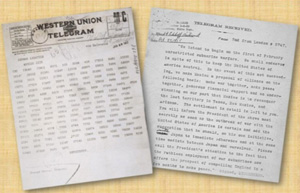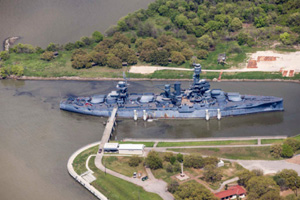Posted on Dec 1, 2022 in
FORT BEND STRONG


The christening of the USS TEXAS in 1912.
She’s 110 years old and recently enjoyed a leisurely cruise from her berth at the San Jacinto Battlefield and Monument to a dry dock in Galveston. She’s the oldest remaining American warship without sails. She’s the only remaining ship in the world that engaged in combat in both World War I and World War II. She’s the only remaining ship that fought in both the Atlantic and Pacific theaters in World War II. She was there when Texan Earl Rudder led his Rangers up the cliffs on Point du Hoc during D Day. She was there when six Marines put up an America flag atop Mount Sirbachi on Iwo Jima. She was there when hurricanes Ike and Harvey hit us. She’s owned by the State of Texas and is the flagship of the Texas Navy. Her designation is BB-35. She’s the Battleship TEXAS!
Uncle Sam paid about six million dollars for our battleship. She was christened USS TEXAS on May 18, 1912. The ceremony was an all-Texas affair with Texan Claudia Lyon breaking a champagne bottle on her bow while saying, “In the name of the United States, I christen thee USS TEXAS!” She was officially commissioned as a ship of war on March 14, 1914. Her ten, 14” main batteries could launch a 1,400-pound, armor-piercing shell twenty-three miles. She was the most powerful warship in human history.

The secret Zimmerman Telegraph.
She was designed to go to toe-to-toe on the high seas with the enemy’s most lethal warships. She was at Vera Cruz when U.S. forces seized the port to stop a shipment of weapons from Germany to aid a revolution in Mexico in 1914. Her crew saw first-hand the rising tensions the United States was having with Mexico. After a German U-boat sank the cruise ship Lusitania on May 7, 1915, we uncovered the secret Zimmerman Telegraph which asked Mexico to join with Germany if the United States entered the war: “We make Mexico a proposal of alliance on the following basis: make war together, make peace together, generous financial support and an understanding on our part that Mexico is to reconquer the lost territory in Texas, New Mexico and Arizona.” We declared war against Germany on April 6, 1917. The USS TEXAS crossed the Atlantic to join the Grand Fleet in the North Sea, where she remained until the end the war.
After World War I, naval warfare was changing and the USS TEXAS was becoming obsolete. During the 1930s, she was converted from coal to fuel oil. She received new armaments to shoot down airplanes. A seaplane was placed on top of one of her massive 14-inch gun turrets. It would be launched to provide more real-time reports of weapons accuracy and effectiveness. The USS TEXAS’ signature tripod masts were installed, too. As World War II was looming, our battleship was ready.
Battleship TEXAS and World War II
World War II began on September 1, 1939 when German Nazi dictator Adolf Hitler unleashed his Blitzkrieg on Poland. The United States was very reluctant to get involved in another European war. One-hundred, seventeen thousand American troops had died in nineteen short months in World War I. The Atlantic Ocean protected us from European aggressors. America was officially neutral in this second European blood bath.
Our attitude quickly changed when, in less than nine months, Hitler controlled the entire European continent except the tiny island nation of Great Britain. President Franklin Roosevelt knew if the Nazis captured Great Britain, it was only a matter of time before Hitler set his sights on us. In response to this developing threat, Congress approved the Lend Lease Act. This Act allowed us to loan surplus military hardware, weapon and support to Great Britain. The USS TEXAS sailed back-and-forth across the Atlantic to make sure these supplies got to Britain without interference from Nazi U-Boats.
American neutrality ended on December 7, 1942 with the surprise attack by Imperial Japan on our Pacific Fleet anchored in Pearl Harbor. “A date which will live in infamy” forced the United States to fight a two-front war – alone in the Pacific and in the Atlantic with Great Britain, France and Soviet Russia. The destruction of our fleet at Pearl Harbor from airplanes launched from ships changed naval warfare forever. Battleships were the most important warships. Pearl Harbor showed us that fast aircraft carriers would win the war. Our carriers’ flank speed was 30+ knots. If a ship could not sail at 30 knots, it was worthless in the Pacific. The USS TEXAS could only go 20 knots. She was kept in the Atlantic and assigned to protect the supply chain from our east coast to Great Britain from the deadly U-boat Wolfpacks. The U-boats sank over 3,000 allied ships during the war.
Our USS TEXAS had been afloat for thirty years and had never fired her 14” guns at the enemy. That changed on November 10, 1942 when she was ordered to join the invasion of North Africa – Operation Torch. With Texan Walter Cronkite aboard, the USS TEXAS watched our forces land in Morocco. Once they were safely ashore, the USS TEXAS unleashed her guns on enemy munition areas and gathering points. She fired 272 shells ashore in two days. After our troops had roared inland, out of range of the USS TEXAS, her work was over. She resumed escort duties against the U-boats. Her greatest military action was coming.
USS TEXAS and D Day
On May 31, 1944, the crew of the USS TEXAS was informed that they would be leading the Allied invasion of France on the beaches of Normandy – D Day! On June 6, 1944, at 5:50 am, the USS TEXAS unleashed 255 14” shells into the German defenses on Omaha Beach. Her fury gave Colonel Earl Rudder’s Rangers time to climb the cliffs at Point du Hoc and take the fight to the Germans.
At 6:26 am, the USS TEXAS began to fire at Omaha Beach to help get our troops off of the beach and the deadly fire from the Germans. Putting herself at risk of being hit by enemy fire, the USS TEXAS closed to just 3,000 yards off shore. At 9:30 pm, the USS TEXAS stopped firing. She had fired 445 shells from her 14” guns. On June 15th, she fired her last round during the D Day invasion, with our troops advancing beyond her range. The USS TEXAS was ordered to quickly proceed to Cherbourg to support an invasion to capture an important port. On June 25th, she began her bombardment of German positions. At 1:16 pm, the USS TEXAS suffered her first and only combat death – Helmsman Christen Christensen was killed when a German shell hit the heart of the ship – the navigation bridge. In three hours, the USS TEXAS experienced 65 near misses. She was ordered to retire at 3:01 pm.
The Move to Japan
Since there would be no more amphibious invasions in Europe, the USS TEXAS was ordered to the Pacific Fleet. She was sent to Iwo Jima. On February 15, 1945, the 14” guns of the USS TEXAS roared to life once more to take out a Japanese airfield and to soften the Japanese defenses on the western side of Iwo Jima. Mount Sirabachi was easily visible from the USS TEXAS when our U.S. Marines raised Old Glory.

Mount Suribachi on the southwest end of Iwo Jima.
The USS TEXAS left Iwo Jima on March 7, 1945 to prepare for her final combat at Okinawa. The USS TEXAS opened fire on Okinawa on March 25th, seven days before the invasion began. She fired for 52 straight days to support our troops ashore and to take down the swarm of suicide kamikaze attackers. When it was all over, the USS TEXAS fired 2,019 14” shells at Okinawa. She left active duty on a high note – she had fired the most extensive and sustained amount of ordnance in her history.
The Battleship Returns Home

The USS TEXAS.
Her active-duty service ended on April 21, 1948. The USS TEXAS was turned over to the Lone Star State on April 30, 1948. Since that time, she has been permanently berthed at the San Jacinto Battlefield.
Since her first launch into the sea in 1912, the USS TEXAS has been fighting a continuous battle – rust and corrosion of her steel hull in salt water. She kept developing leak after leak after leak.
On December 13, 1988, she barely made it to a drydock in Galveston. Her draft sank two feet during the six-hour tow. Repairs complete, the USS TEXAS returned to San Jacinto on July 26, 1990. Mother Nature was unrelenting and kept attacking our beloved ship. By 2020, the USS TEXAS was taking on 2,000 gallons of seawater PER MINUTE. We had to get her to a drydock once again. Having learned a lot from her first trip to Galveston, the USS TEXAS had a smooth trip to Galveston in August of this year. It was a gorgeous day for a sail down the Houston Ship Channel, with many of our neighbors proudly watching our battleship underway again.
Her hull will be repaired for at least the next two years. After she is repaired, we have to decide where she will call home. One thing is very clear to me – she needs to be removed from salt water, because we will always lose to corrosion. We can’t let the essence of Texas’ fortitude, strength and can-do attitude fall apart! I do not know the answer, but “failure is not an option.” Please send me your thoughts as to where the USS TEXAS should go to pete@absolutelyfamousmedia.com.
Enjoy the holidays with your family knowing that, working together, like the sailors on the USS TEXAS (BB-35), we make Fort Bend Strong!

 <
<











